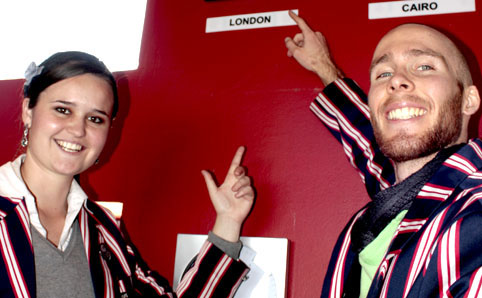|

|
|
Nida Jooste and Ryan Lamb
Photo: Earl Coetzee
|
Academic excellence and strong leadership has become synonymous with our university, as our two Rhodes scholars for 2011, and the recent announcement of our two Abe Bailey scholars from the UFS have shown.
Nida Jooste and Ryan Lamb are two of the proud recipients of Abe Bailey Travel Bursaries and will be heading off to the United Kingdom on 26 August 2011, to visit several universities in England and Scotland. These two were chosen from hundreds of UFS applicants and will join Abe Bailey bursary holders from the rest of the country.
Both students are academic achievers, but also excel in other fields. This is what set them apart from the rest of the applicants for the bursaries.
Ryan (23), a Medical Physics honours student at our Faculty of Health Sciences, received the Senate Medal for the best bachelor’s degree student at the UFS. He was one of a hundred students at the Brightest Young Minds Summit this year and was one of the 2008 delegates to the World Youth Forum, hosted by the International Association for Poetry and Solidarity in Italy.
This young man is the founder of a group called Poets Anonymous, which provides a platform where poets, artists and dancers in Bloemfontein can express themselves.
Nida (21) is a very familiar face on our Bloemfontein Campus, as she served as the Deputy Chairperson of the Interim Student Council for the past year.
This fourth-year LL.B. student says she has known about the Abe Bailey bursary since her first year, but had to wait to apply, since the scholarship is only open to final-year students and junior lecturers. She applied last year, but did not even make it to the short list for candidates.
“I realise now that I was not involved enough then. Luckily I became much more involved in campus activities during the past year and also improved my academic performance greatly,” she says.
Nida and Ryan both hope to use the opportunity to learn new approaches to solving problems. Ryan says he is looking forward to the opportunity to network with other bursary holders and to share experiences with them, before returning to the UFS to implement what he had learned.
Nida says she also hopes to see how universities in First-World Countries operate, in order to apply that knowledge when she returns to the UFS.